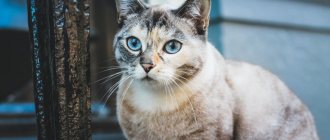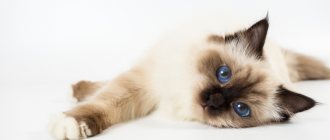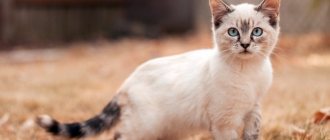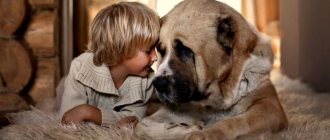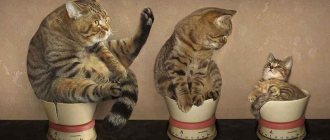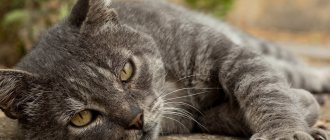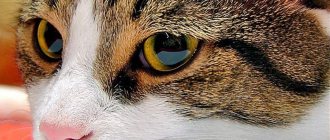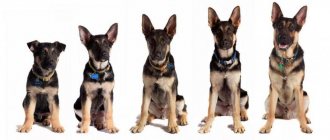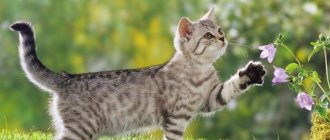Why do you need to know the age of cats?
Having found out how old your pet is, you can properly adjust its care, balance its diet, and better monitor its health. It is impossible not to take into account changes in years, because this will have a bad effect on the standard of living of your mustachioed friend. Why else might such knowledge be useful:
- Determine the level of physical activity, the intensity of which decreases with age. Excessive play with an elderly person will have a bad effect on the joints and cardiovascular system. But for younger people, lack of activity will negatively affect physical development or lead to dangerous obesity.
- The cat's health is monitored in accordance with physiological changes. For example, only older individuals are susceptible to cataracts. Therefore, caring for mature pets should be more thorough.
- The selection of diet must be correlated with the characteristics of the period of life. Nutrition must meet the needs of the body. For example, older cats find it difficult to eat dry food because their teeth have worn out and become more brittle. They are no longer adapted to rough food.
Knowing the degree of maturity, it is not difficult to help your mustachioed friend develop fully and provide him with good care and proper nutrition. The quality of life and attention of the owner will prolong the cat’s life.
Periods of a pet's life
According to research by zoological scientists, the life of a mustachioed friend goes through different stages. Each of them is characterized by its own physiological, behavioral and psychological characteristics. There are 6 stages of cat age:
- Childhood
lasts from birth to six months. This is a time of rapid growth, as well as formation until the onset of puberty.
- Youth
– period from 6 months to 2 years. This is the stage of preparing the body for adulthood. The growth of the mustachioed friend continues, but at a reduced pace.
- Heyday
– time from 2 to 7 years. This is the peak of increased physical and mental activity: the pet has a strong skeleton, healthy teeth and beautiful coat.
- Maturity
– stage from 7 to 11 years. Then a slight decrease in physical activity begins, but in general the cat’s age is not so noticeable.
- Elderly age
– stage from 11 to 15 years. Vitality is gradually lost. The appearance and quality of fur, claws, and teeth deteriorate. The first health problems appear.
- Old age
. After 15 years, a decrease in various types of activity is clearly expressed, sleep time increases, and an increased risk of various diseases arises.
This division into stages becomes fundamental when understanding the degree of maturity of a cat. Awareness helps in proper care and maintenance. Veterinarians quite easily determine the age of a cat based on physiological data and behavioral characteristics of each period.
Odds table
The most popular method is to use a coefficient table. This is a special number that approximately determines how many human years pass while a pet lives 1 year.
It is incorrect to compare the psychological characteristics, logic and thinking of cats and people, so scientists have created a special plate showing the ratio of cat and human ages. If the exact age is unknown, any veterinarian can determine it (by the animal’s teeth and the general condition of the body).
Determining the number of years lived
It is difficult for an inexperienced owner to determine the age of a cat without the help of a specialist. An experienced breeder is able to accurately indicate the age of his pet, but it would be best to show the animal to a veterinarian. The specialist will not only tell you how old the cat is, but will also paint a general picture of her condition. In veterinary practice, there are several criteria for determining the age of animals.
According to the condition of the teeth
Veterinarians can easily determine the amount of time an animal has lived by looking at its teeth. This method is effective for different individuals, from kittens to old people. This fact can be explained by the fact that the schedule for replacing baby teeth with molars is quite strict. The strength of the fangs and their color are the best indicators of not only the health of the pet, but also its maturity.
| Number of years | Condition of the oral cavity |
| 5 weeks | Baby teeth erupting |
| 6 months | Dairy products are completely replaced by permanent indigenous ones. |
| 1 year | The canines should be in the best condition, white and strong |
| 1.5 years | The incisors on the lower jaw begin to wear off |
| 2 years | The enamel becomes yellow in color and traces of deposits appear |
| 4-5 years | The incisors on the lower jaw wear away very noticeably |
| 6 years | Abrasions on the fangs begin to appear, dark spots appear on the enamel |
| 7 years | The surviving incisors are completely worn away. Fangs in poor condition |
| 10 years | Half of the teeth are lost |
| 13-15 years old | Fangs fall out |
Table 1. Age of cats according to dental condition
The influence of time lived on the condition of the oral cavity is very noticeable. Unfortunately, the owner rarely pays attention to this and is in no hurry to change the pet’s diet when necessary. It would be a good idea to make periodic visits to a veterinarian-dentist, who will assess the condition of the oral cavity and tell you how to prevent teeth from wearing out too early.
According to the condition of the coat
The pet's appearance helps determine a cat's age. This method of definition is the most understandable for a non-specialist. However, veterinarians do not consider this method to be unambiguous, because environmental factors and living conditions can affect the condition of the coat and skin. Good care plus a balanced diet allows you to maintain an excellent appearance even in older individuals. There are only generalized signs that help determine the degree of maturity of a pet.
| Number of years | Type of coat |
| 0-1 | Hair is soft and shiny. There are no signs of baldness or tangles |
| 1-7 | A healthy individual has fur in excellent condition: smooth, fluffy, with a good pattern. Gray hair is completely absent |
| 8-15 | The hair is dull and thin. Tangles and bald spots often appear |
Table 2. Age of cats according to coat condition
This method of determination has many disadvantages. Representatives of some breeds have no hair at all or their hair is quite short and coarse. This makes it much more difficult to figure out changes over the years.
According to changes in the musculoskeletal system
Proper distribution of physical activity helps maintain energy and lightness until old age. In this regard, changes in the skeleton do not become a sign that the owner pays attention to. However, for a veterinarian, bones and muscles are the best indicator of a pet's maturity.
In mature individuals, the muscles are developed in proportion to the skeleton. After final puberty, the pet acquires the characteristic features of the breed’s exterior. In addition, a mature musculoskeletal system has a number of common features:
- pronounced muscle relief;
- gracefulness and ease of movement;
- increased activity, endurance.
In older animals, after 8 years of life, the first signs of aging begin to appear. They are not too noticeable, but already create inconvenience for an active individual. The changes are clearly visible in short-haired breeds. Such manifestations include:
- Sunken spine, protruding shoulder blades.
- Lack of ease of movement. Sometimes they are given to an elderly pet with great effort.
- The volume of muscle tissue decreases noticeably, and the remaining muscles become decrepit.
Aging felines often suffer from thinness. If the pet has excess fat, then some criteria are noticeably smoothed out. The most obvious sign of this is difficulty moving.
According to eye condition
The eyes are not the most accurate way to determine old age, since noticeable changes only begin in older animals. Until the age of 10, the eyes of kittens and mature cats are almost no different.
An indicator of old age is the iris, which can be:
- cloudy;
- covered with patches;
- with uneven, blurry edges;
- with faded color.
An eyesore also indicates that the cat's youth has passed. A non-obvious sign is that the eye becomes very wet, but this does not happen in every older cat.
Cat to human age ratio
Experts name three methods for comparing the life periods of people and cats. Unfortunately, none of them is considered absolutely accurate, so the age of a cat by human standards is always only approximate.
First way
The starting point is 1 year. This period is the time of puberty of the animal. This age corresponds to 16 years of age. Another milestone is 2 years, at which time the formation of the pet’s character and habits ends. This happens at 24 years old by human standards. After 3 years, the pet’s maturity is determined using the formula:
x = 24 + ((number of years – 2) * 4)
For example, your cat is 6 years old. This means you need to subtract two (you get four), multiply by four (you get 16), and then add twenty-four. It turns out that a six-year-old cat, by human standards, is exactly 40 years old.
Second way
Another method is to calculate the number of years in each of the three periods of life. This method is considered more accurate than the previous one due to the detailed nature of the calculations. The degree of maturity can be determined using the following formulas:
| Number of years (z) | Formula |
| 1-5 | x = z * 7 |
| 6-11 | x = (z – 5) * 4 + 35 |
| 12-20 | x = (z – 11) * 3 + 59 |
Third way
This technique has a scientific basis and was developed by veterinarians together with zoological scientists. The basis is an indicator that takes into account the intellectual, psychological and physiological level of development, converting a cat’s age to a human age in the table.
| Number of years of the cat | Number of years of a person |
| 1 | 18-19 |
| 2 | 25 |
| 3 | 32-33 |
| 4 | 35-36 |
| 5 | 40-41 |
| 6 | 43-45 |
| 7 | 46-47 |
| 8 | 50-52 |
| 9 | 55-56 |
| 10 | 60-62 |
| 11 | 64-65 |
| 12 | 67-68 |
| 13 | 70 |
| 14 | 72-73 |
| 15 | 75 |
| 16 | 76-77 |
| 17 | 78 |
| 18 | 83 |
| 19 | 91 |
| 20 | 100 |
Table 3. Age of a cat by human standards
Despite such a detailed table, it should be remembered that an accurate comparison of two fundamentally different biological species is almost impossible. A cat's age by human standards can vary. The rate of development of human and animal organisms has few similar characteristics. Here it is worth taking into account the difference in breeds and gender differences.
Features of the development of dogs in comparison with humans
Dogs grow up differently. If we compare the stages of development of dogs and humans, we get the following picture:
- 0–1 month. By the age of one month, the puppy begins to actively explore the surrounding space. In this, he resembles a one-year-old child who is trying out many things. Such a baby knows no fear, and he needs care and constant supervision.
- 1–4 months. By the age of four months, an inquisitive puppy begins to be trained at the training ground. He begins to change teeth, like seven-year-old children, and he is just as careless and playful.
- 4–6 months. A dog at 6 months of age who is entering puberty can be compared to a 14-year-old teenager. The puppy's body grows unevenly, he has a childish perception of the world around him, and the dog's mood often changes.
- 6 months – 1 year. The age of 12 months for a dog corresponds to 16–18 years for a person. At this time the dog stops growing. She becomes more self-confident, males strive to establish leadership between their fellow tribesmen.
- 1–2 years. A two-year-old dog reaches the peak of its physical development, like a twenty-year-old person. Bitches at this time are already ready for motherhood. The dogs have already been trained in all commands.
- After five years. From this age, the dog begins to slowly age, like a forty-year-old person. The animal becomes more restrained and calm, it already has all the skills and knowledge for everyday life.
- 8 or more years. Dogs are entering their retirement period, that is, their bodies begin to age quickly. Similar changes occur in people aged 60–70 years. Dogs need to be given a more balanced diet and limited exercise.
Is it possible to increase the lifespan of a cat?
Any owner dreams of having a furry family member to please him for as long as possible. And he has the power to do everything so that the cat lives for 15, or even 20 years. What will prolong the life of your beloved four-legged animal:
- Annual vaccination
. The kitten is vaccinated in the first 2-3 months of life and then the procedure is repeated every year. This will protect both your indoor and outdoor cats from the most terrible viruses with a high fatality rate.
- Routine examination by a veterinarian
. Non-pedigreed cats get sick less, so they can be shown to the veterinarian during vaccination once a year - just ask the doctor about this. Pedigree animals and animals with chronic diseases require more frequent visits to the veterinary clinic - the frequency will be determined by the veterinarian himself.
- Sterilization and castration
. If you do not plan to breed kittens, be sure to sterilize your pet - this will help avoid many problems, including diseases of the genitourinary system and mental disorders.
- Attention to any changes in your pet's behavior
. Has your cat started drinking a lot? Stopped sleeping in your favorite chair? Is he limping? Are there strange discharges? Even such little things require close attention from the owner. The first action in case of suspicion is to call the veterinarian, he will tell you whether you need to take the animal to the clinic or if you can watch it at home.
- Purity
- the key to health. Cats groom themselves, but this is not enough to maintain hygiene. For example, long-haired breeds cannot cope with caring for a luxurious fur coat, and it must be combed regularly to prevent parasites or skin diseases. It is necessary to thoroughly rinse the cat's food and water bowls, disinfect the trays, and wash the bedding.
- Nutrition
must be maintained at a high level. It is not so important what you feed your cat - the main thing is that the selected diet suits it. A young cat will benefit from both natural food and high-quality dry food. But kittens and elderly individuals require a special menu, which cannot be cheap. Therefore, before getting a cat, think about the fact that in old age, in 95% of cases, it will require greater expenses than in youth.
- Treat your cat like a family member
. Consider the nature of the pet and its needs. If she doesn't tolerate loneliness well, you shouldn't leave her in the apartment all day. And on the contrary - if the kitty loves isolation, respect her personal space. There are many such points, and if you do not pay attention to the psychological state of the animal, it will constantly be sick and will not live very long.
This is not a complete list of what a loving owner can do. The most important thing is to be attentive and patient, treating your pet as a younger member of the family. Then he will live very long and happily.
Long-livers in the world of cats
You always want to believe that a pet will become a happy exception and turn into the smartest/obedient/beautiful/healthy/long-living cat in the world. And indeed, this sometimes happens - and not so rarely. But some cases are like a miracle.
Long-lived breeds
Before getting a purebred cat, it is advisable to find out what diseases it is predisposed to and how many years it lives on average. Breeds that can easily live 18-20 years include:
- Savannahs (one of the most expensive cats);
- Siamese cats;
- Manx;
- Persian cats;
- rexes (Cornish, Devon and others);
- Egyptian Mau;
- Burmese;
- Russians are blue.
Their life expectancy is due to good genetics and good health. However, this list can include the most common “breed” in the world – an ordinary yard cat. Outbred mustachios easily break records, living up to 20 years with good care and the absence of diseases.
Cat age
When purchasing a furry friend, the owner and household members must understand that cats do not live as long as humans. When figuring out how many years a cat goes through a year, the owner is most often interested in the animal’s life expectancy. An indicator such as the average life expectancy of furry couch potatoes depends on many factors.
Of course, the lifespan of a cat is a very average indicator. Pets are known to live 30 years or more. However, such long-livers are rather an exception in the world of furry couch potatoes.
